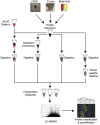Quantitative Mass Spectrometry-Based Proteomic Profiling for Precision Medicine in Prostate Cancer
- PMID: 29164064
- PMCID: PMC5674010
- DOI: 10.3389/fonc.2017.00267
Quantitative Mass Spectrometry-Based Proteomic Profiling for Precision Medicine in Prostate Cancer
Abstract
Prostate cancer (PCa) is one of the most frequently diagnosed cancer among men in the western societies. Many PCa patients bear tumors that will not threat their lives if left untreated or if treatment is delayed. Our inability for early identification of these patients has resulted in massive overtreatment. Therefore, there is a great need of finding biomarkers for patient stratification according to prognostic risk; as well as there is a need for novel targets that can allow the development of effective treatments for patients that progress to castration-resistant PCa. Most biomarkers in cancer are proteins, including the widely-used prostate-specific antigen (PSA). Recent developments in mass spectrometry allow the identification and quantification of thousands of proteins and posttranslational modifications from small amounts of biological material, including formalin-fixed paraffin-embedded tissues, and biological fluids. Novel diagnostic and prognostic biomarkers have been identified in tissue, blood, urine, and seminal plasma of PCa patients, and new insights in the ethology and progression of this disease have been achieved using this technology. In this review, we summarize these findings and discuss the potential of this technology to pave the way toward the clinical implementation of precision medicine in PCa.
Keywords: FFPE; biofluid proteomics; diagnostic biomarker; mass spectrometry; prognostic biomarker; prostate cancer proteomics; proteome.
Figures
Similar articles
-
The Proteome of Primary Prostate Cancer.Eur Urol. 2016 May;69(5):942-52. doi: 10.1016/j.eururo.2015.10.053. Epub 2015 Dec 2. Eur Urol. 2016. PMID: 26651926
-
Proteomics in diagnosis of prostate cancer.Pril (Makedon Akad Nauk Umet Odd Med Nauki). 2015;36(1):5-36. Pril (Makedon Akad Nauk Umet Odd Med Nauki). 2015. PMID: 26076772 Review.
-
High-throughput proteomic analysis of FFPE tissue samples facilitates tumor stratification.Mol Oncol. 2019 Nov;13(11):2305-2328. doi: 10.1002/1878-0261.12570. Epub 2019 Sep 18. Mol Oncol. 2019. PMID: 31495056 Free PMC article.
-
More advantages in detecting bone and soft tissue metastases from prostate cancer using 18F-PSMA PET/CT.Hell J Nucl Med. 2019 Jan-Apr;22(1):6-9. doi: 10.1967/s002449910952. Epub 2019 Mar 7. Hell J Nucl Med. 2019. PMID: 30843003
-
The role of proteomics in prostate cancer research: biomarker discovery and validation.Clin Biochem. 2013 Apr;46(6):524-38. doi: 10.1016/j.clinbiochem.2012.12.012. Epub 2012 Dec 22. Clin Biochem. 2013. PMID: 23266295 Review.
Cited by
-
Complementary analysis of proteome-wide proteomics reveals changes in RNA binding protein-profiles during prostate cancer progression.Cancer Rep (Hoboken). 2023 Oct;6(10):e1886. doi: 10.1002/cnr2.1886. Epub 2023 Aug 17. Cancer Rep (Hoboken). 2023. PMID: 37591798 Free PMC article.
-
Characterization of HMGB1/2 Interactome in Prostate Cancer by Yeast Two Hybrid Approach: Potential Pathobiological Implications.Cancers (Basel). 2019 Nov 5;11(11):1729. doi: 10.3390/cancers11111729. Cancers (Basel). 2019. PMID: 31694235 Free PMC article.
-
Absolute Quantification of Apolipoproteins Following Treatment with Omega-3 Carboxylic Acids and Fenofibrate Using a High Precision Stable Isotope-labeled Recombinant Protein Fragments Based SRM Assay.Mol Cell Proteomics. 2019 Dec;18(12):2433-2446. doi: 10.1074/mcp.RA119.001765. Epub 2019 Oct 7. Mol Cell Proteomics. 2019. PMID: 31591263 Free PMC article. Clinical Trial.
-
Theranostics in Boron Neutron Capture Therapy.Life (Basel). 2021 Apr 10;11(4):330. doi: 10.3390/life11040330. Life (Basel). 2021. PMID: 33920126 Free PMC article. Review.
-
Mass spectrometry-based tear proteomics for noninvasive biomarker discovery.Mass Spectrom Rev. 2022 Sep;41(5):842-860. doi: 10.1002/mas.21691. Epub 2021 Mar 24. Mass Spectrom Rev. 2022. PMID: 33759206 Free PMC article. Review.
References
-
- Liu Y, Chen J, Sethi A, Li QK, Chen L, Collins B, et al. Glycoproteomic analysis of prostate cancer tissues by SWATH mass spectrometry discovers N-acylethanolamine acid amidase and protein tyrosine kinase 7 as signatures for tumor aggressiveness. Mol Cell Proteomics (2014) 13(7):1753–68.10.1074/mcp.M114.038273 - DOI - PMC - PubMed
Publication types
LinkOut - more resources
Full Text Sources
Other Literature Sources
Research Materials
Miscellaneous


